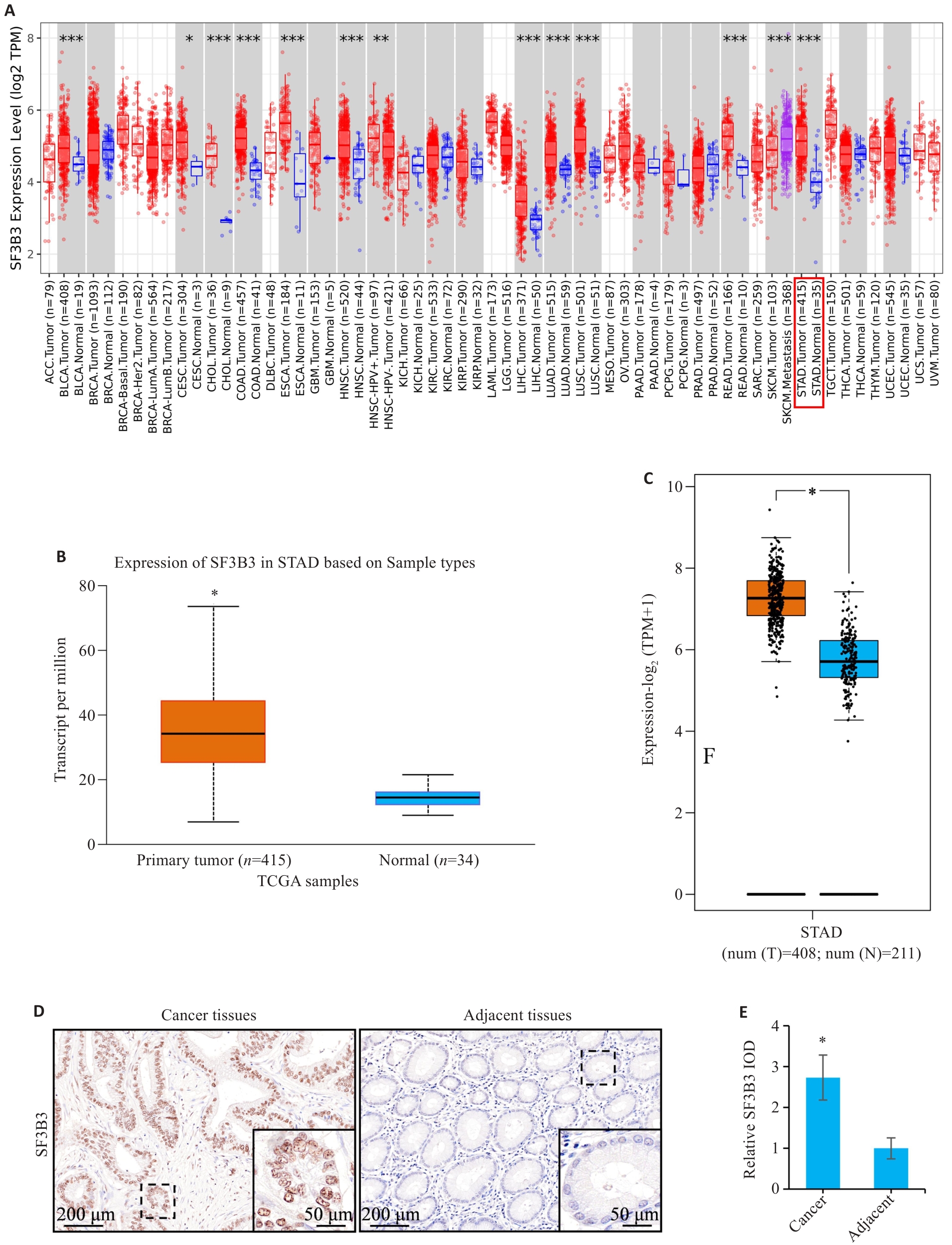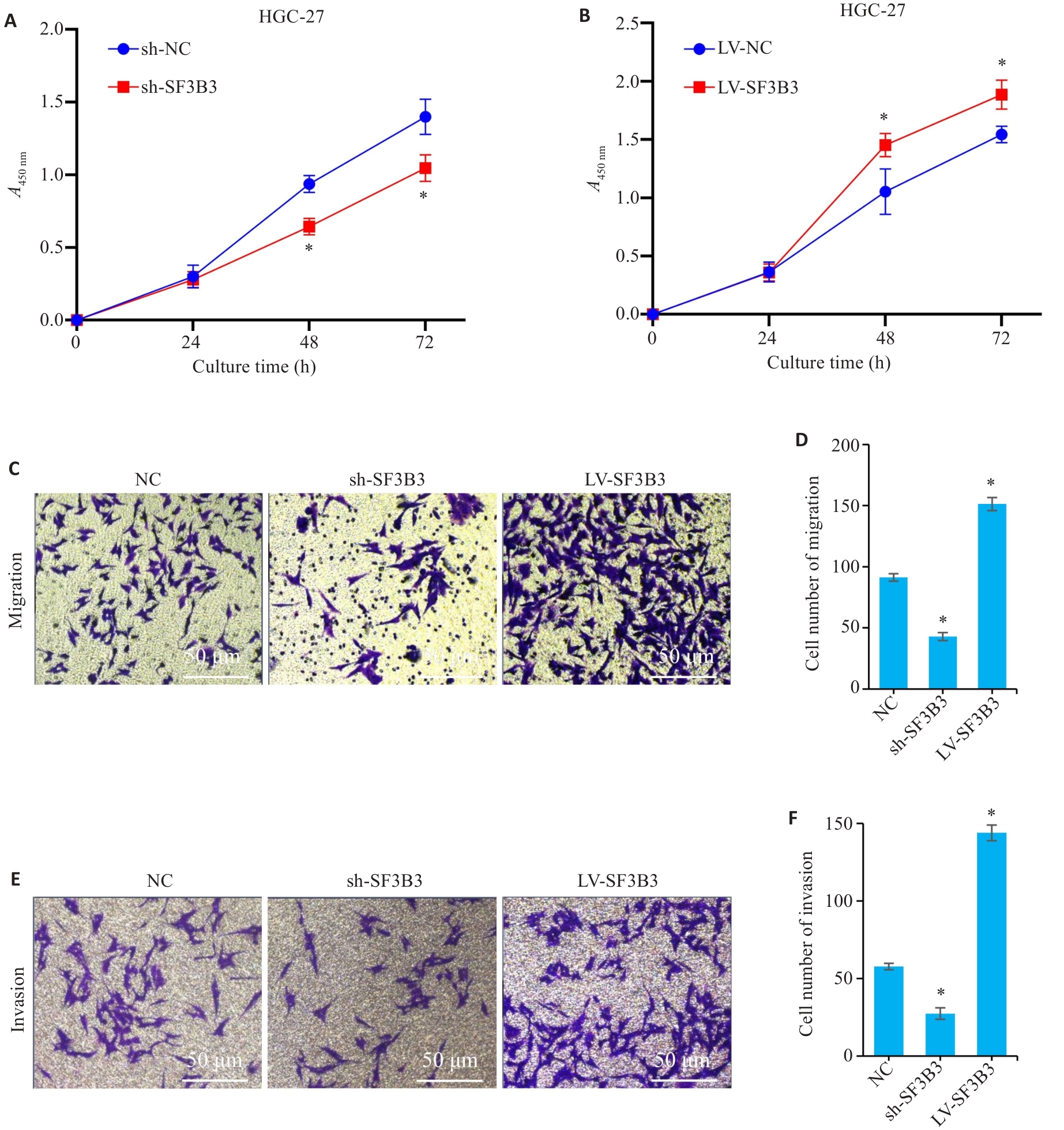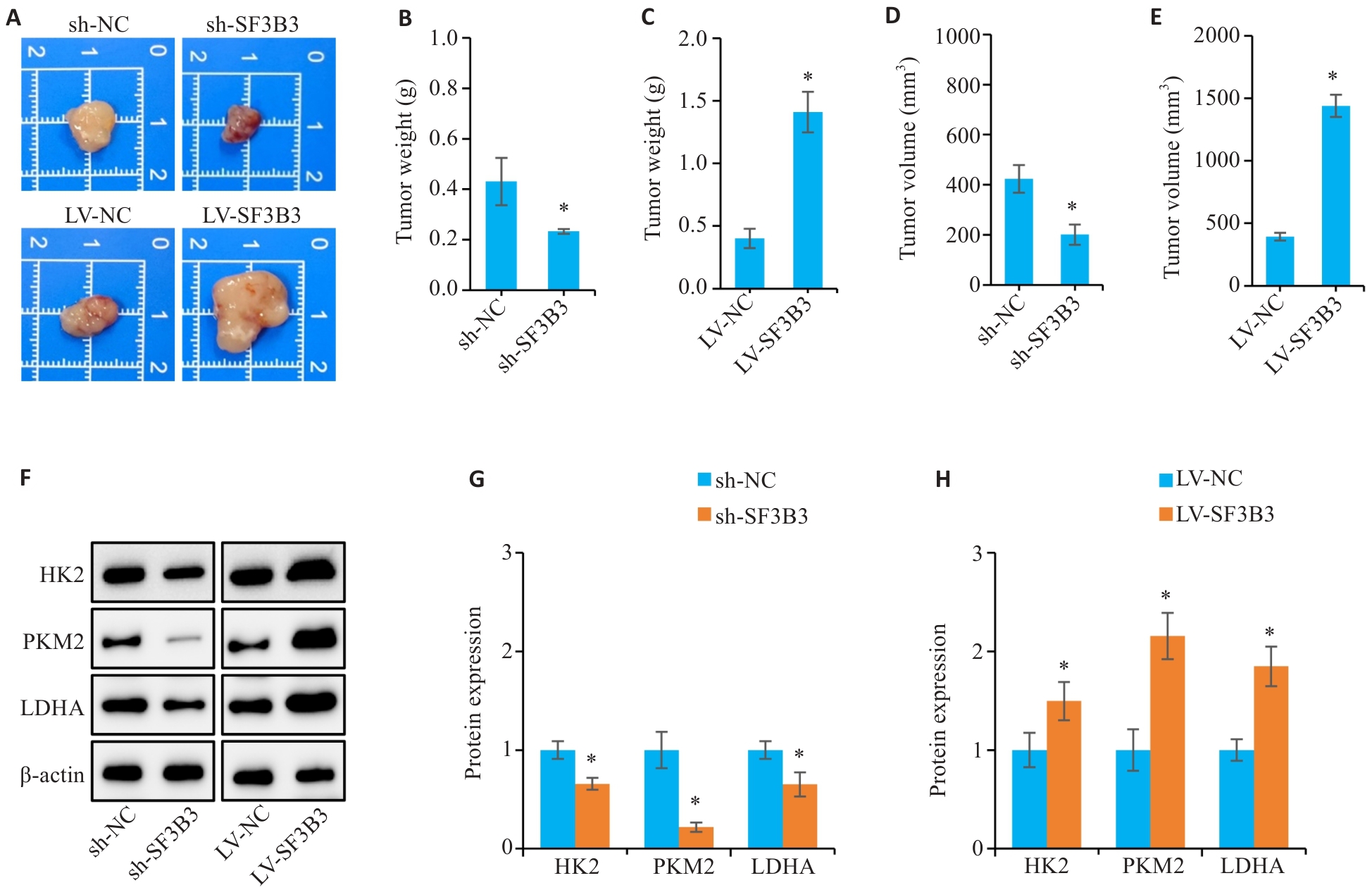Journal of Southern Medical University ›› 2025, Vol. 45 ›› Issue (10): 2240-2249.doi: 10.12122/j.issn.1673-4254.2025.10.20
Hui LU1,2( ), Bowen SONG1,2, Jinran SHI3, Shunyin WANG3, Xiaohua CHEN1,2, Jingjing YANG1,2, Sitang GE1,4, Lugen ZUO1,4(
), Bowen SONG1,2, Jinran SHI3, Shunyin WANG3, Xiaohua CHEN1,2, Jingjing YANG1,2, Sitang GE1,4, Lugen ZUO1,4( )
)
Received:2025-02-16
Online:2025-10-20
Published:2025-10-24
Contact:
Lugen ZUO
E-mail:Lu15855787559@163.com;zuolugen@126.com
Hui LU, Bowen SONG, Jinran SHI, Shunyin WANG, Xiaohua CHEN, Jingjing YANG, Sitang GE, Lugen ZUO. SF3B3 overexpression promotes proliferation of gastric cancer cells and correlates with poor patient prognosis[J]. Journal of Southern Medical University, 2025, 45(10): 2240-2249.
Add to citation manager EndNote|Ris|BibTeX
URL: https://www.j-smu.com/EN/10.12122/j.issn.1673-4254.2025.10.20

Fig.1 Overexpression of SF3B3 in stomach adenocarcinoma. A: Differential expression profiles of SF3B3 in diverse cancerous lesions. B, C: Analysis of SF3B3 expression between gastric cancer and adjacent benign tissues. D, E: Immunohistochemistry for SF3B3 in paired gastric carcinoma and adjacent normal tissues. *P<0.05, **P<0.01, ***P<0.001.
| Factor | n | SF3B3 expression (n, %) | χ² | P | |
|---|---|---|---|---|---|
| Low (n=53) | High (n=54) | ||||
| Gender | |||||
| Male | 45 | 26 (57.78%) | 19 (42.22%) | 2.112 | 0.146 |
| Female | 62 | 27 (43.55%) | 35 (56.45%) | ||
| Age (year) | |||||
| <60 | 36 | 18 (50.00%) | 18 (50.00%) | 0.005 | 0.945 |
| ≥60 | 71 | 35 (49.30%) | 36 (50.70%) | ||
| CEA (μg/L) | |||||
| <5 | 51 | 36 (70.59%) | 15 (29.41%) | 17.282 | <0.001 |
| ≥5 | 56 | 17 (30.36%) | 39 (69.64%) | ||
| CA19-9 (kU/L) | |||||
| <37 | 53 | 36 (67.92%) | 17 (32.08%) | 14.211 | <0.001 |
| ≥37 | 54 | 17 (31.48%) | 37 (68.52%) | ||
| Tumor size (cm) | |||||
| <5 | 49 | 28 (57.14%) | 21 (42.86%) | 2.094 | 0.148 |
| ≥5 | 58 | 25 (43.10%) | 33 (56.90%) | ||
| Histological type | |||||
| Adenocarcinoma | 84 | 44 (52.38%) | 40 (47.62%) | 1.268 | 0.260 |
| Other | 23 | 9 (39.13%) | 14 (60.87%) | ||
| Pathological grading | |||||
| G1-G2 | 53 | 27 (50.94%) | 26 (49.06%) | 0.084 | 0.772 |
| G3-G4 | 54 | 26 (48.15%) | 28 (51.85%) | ||
| T stage | |||||
| T1-T2 | 48 | 31 (64.58%) | 17 (35.42%) | 7.888 | 0.005 |
| T3-T4 | 59 | 22 (37.29%) | 37 (62.71%) | ||
| N stage | |||||
| N0-N1 | 63 | 40 (63.49%) | 23 (36.51%) | 11.943 | <0.001 |
| N2-N3 | 44 | 13 (29.55%) | 31 (70.45%) | ||
Tab.1 SF3B3 expression patterns in relation to clinicopathological features of gastric cancer patients
| Factor | n | SF3B3 expression (n, %) | χ² | P | |
|---|---|---|---|---|---|
| Low (n=53) | High (n=54) | ||||
| Gender | |||||
| Male | 45 | 26 (57.78%) | 19 (42.22%) | 2.112 | 0.146 |
| Female | 62 | 27 (43.55%) | 35 (56.45%) | ||
| Age (year) | |||||
| <60 | 36 | 18 (50.00%) | 18 (50.00%) | 0.005 | 0.945 |
| ≥60 | 71 | 35 (49.30%) | 36 (50.70%) | ||
| CEA (μg/L) | |||||
| <5 | 51 | 36 (70.59%) | 15 (29.41%) | 17.282 | <0.001 |
| ≥5 | 56 | 17 (30.36%) | 39 (69.64%) | ||
| CA19-9 (kU/L) | |||||
| <37 | 53 | 36 (67.92%) | 17 (32.08%) | 14.211 | <0.001 |
| ≥37 | 54 | 17 (31.48%) | 37 (68.52%) | ||
| Tumor size (cm) | |||||
| <5 | 49 | 28 (57.14%) | 21 (42.86%) | 2.094 | 0.148 |
| ≥5 | 58 | 25 (43.10%) | 33 (56.90%) | ||
| Histological type | |||||
| Adenocarcinoma | 84 | 44 (52.38%) | 40 (47.62%) | 1.268 | 0.260 |
| Other | 23 | 9 (39.13%) | 14 (60.87%) | ||
| Pathological grading | |||||
| G1-G2 | 53 | 27 (50.94%) | 26 (49.06%) | 0.084 | 0.772 |
| G3-G4 | 54 | 26 (48.15%) | 28 (51.85%) | ||
| T stage | |||||
| T1-T2 | 48 | 31 (64.58%) | 17 (35.42%) | 7.888 | 0.005 |
| T3-T4 | 59 | 22 (37.29%) | 37 (62.71%) | ||
| N stage | |||||
| N0-N1 | 63 | 40 (63.49%) | 23 (36.51%) | 11.943 | <0.001 |
| N2-N3 | 44 | 13 (29.55%) | 31 (70.45%) | ||

Fig.6 Elevated SF3B3 levels enhance proliferative, migration, and invasive abilities of HGC-27 cells. A: Impact of SF3B3 knockdown on proliferation of HGC-27 cells. B: Impact of SF3B3 overexpression on proliferation of HGC-27 cells. C-F: Assessment of migration and invasion of HGC-27 cells. NC: Negative control; sh-NC: Short hairpin RNA negative control; LV-NC: Lentivirus negative control. *P<0.05 vs NC.

Fig.8 Role of SF3B3 in augmenting tumorigenesis in nude mice and its impact on glycolytic activity in vivo. A: Comparison of xenograft growth among the groups. B, C: Measurement of tumor weight in nude mice. D, E: Quantification of tumor volume in nude mice. F-H: Assessment of HK2, PKM2, and LDHA protein expression using Western blotting in tumor xenografts. *P<0.05 vs sh-NC or LV-NC group.
| [1] | Smyth EC, Nilsson M, Grabsch HI, et al. Gastric cancer[J]. Lancet, 2020, 396(10251): 635-48. doi:10.1016/s0140-6736(20)31288-5 |
| [2] | Bray F, Laversanne M, Sung H, et al. Global cancer statistics 2022: GLOBOCAN estimates of incidence and mortality worldwide for 36 cancers in 185 countries[J]. CA Cancer J Clin, 2024, 74(3): 229-63. doi:10.3322/caac.21834 |
| [3] | Li Y, Feng A, Zheng S, et al. Recent estimates and predictions of 5-year survival in patients with gastric cancer: a model-based period analysis[J]. Cancer Control, 2022, 29: 10732748221099227. doi:10.1177/10732748221099227 |
| [4] | Guan WL, He Y, Xu RH. Gastric cancer treatment: recent progress and future perspectives[J]. J Hematol Oncol, 2023, 16(1): 57. doi:10.1186/s13045-023-01451-3 |
| [5] | Yang WJ, Zhao HP, Yu Y, et al. Updates on global epidemiology, risk and prognostic factors of gastric cancer[J]. World J Gastroenterol, 2023, 29(16): 2452-68. doi:10.3748/wjg.v29.i16.2452 |
| [6] | Zeng YJ, Jin RU. Molecular pathogenesis, targeted therapies, and future perspectives for gastric cancer[J]. Semin Cancer Biol, 2022, 86: 566-82. doi:10.1016/j.semcancer.2021.12.004 |
| [7] | Hou W, Zhao Y, Zhu H. Predictive biomarkers for immunotherapy in gastric cancer: current status and emerging prospects[J]. Int J Mol Sci, 2023, 24(20): 15321. doi:10.3390/ijms242015321 |
| [8] | Röcken C. Predictive biomarkers in gastric cancer[J]. J Cancer Res Clin Oncol, 2023, 149(1): 467-81. doi:10.1007/s00432-022-04408-0 |
| [9] | Matsuoka T, Yashiro M. Bioinformatics analysis and validation of potential markers associated with prediction and prognosis of gastric cancer[J]. Int J Mol Sci, 2024, 25(11): 5880. doi:10.3390/ijms25115880 |
| [10] | Zhao XH, Li K, Chen MY, et al. Metabolic codependencies in the tumor microenvironment and gastric cancer: Difficulties and opportunities[J]. Biomed Pharmacother, 2023,162:114601. doi:10.1016/j.biopha.2023.114601 |
| [11] | Fendt SM. 100 years of the Warburg effect: a cancer metabolism endeavor[J]. Cell, 2024, 187(15): 3824-8. doi:10.1016/j.cell.2024.06.026 |
| [12] | Li Y, Ma H. circRNA PLOD2 promotes tumorigenesis and Warburg effect in colon cancer by the miR-513a-5p/SIX1/LDHA axis[J]. Cell Cycle, 2022, 21(23): 2484-98. doi:10.1080/15384101.2022.2103339 |
| [13] | Shang S, Wang MZ, Xing Z, et al. Lactate regulators contribute to tumor microenvironment and predict prognosis in lung adenocarcinoma[J]. Front Immunol, 2022, 13: 1024925. doi:10.3389/fimmu.2022.1024925 |
| [14] | 侯鑫睿, 张振东, 曹明远,等. 红景天苷靶向miR-1343-3p-OGDHL/PDHB糖代谢轴抑制胃癌细胞的体内外增殖[J]. 南方医科大学学报, 2025, 45(6): 1226-39. |
| [15] | Bai R, Wan R, Yan C, et al. Structures of the fully assembled Saccharomyces cerevisiae spliceosome before activation[J]. Science, 2018, 360(6396): 1423-9. doi:10.1126/science.aau0325 |
| [16] | Sun CF. The SF3b complex: splicing and beyond[J]. Cell Mol Life Sci, 2020, 77(18): 3583-95. doi:10.1007/s00018-020-03493-z |
| [17] | Wan R, Bai R, Zhan X, et al. How is precursor messenger RNA spliced by the spliceosome?[J]. Annu Rev Biochem, 2020, 89: 333-58. doi:10.1146/annurev-biochem-013118-111024 |
| [18] | Gökmen-Polar Y, Neelamraju Y, Goswami CP, et al. Expression levels of SF3B3 correlate with prognosis and endocrine resistance in estrogen receptor-positive breast cancer[J]. Mod Pathol, 2015, 28(5): 677-85. doi:10.1038/modpathol.2014.146 |
| [19] | Lin YH, Wu MH, Liu YC, et al. LINC01348 suppresses hepatocellular carcinoma metastasis through inhibition of SF3B3-mediated EZH2 pre-mRNA splicing[J]. Oncogene, 2021, 40(28): 4675-85. doi:10.1038/s41388-021-01905-3 |
| [20] | Zhang S, Zhang J, An Y, et al. Multi-omics approaches identify SF3B3 and SIRT3 as candidate autophagic regulators and druggable targets in invasive breast carcinoma[J]. Acta Pharm Sin B, 2021, 11(5): 1227-45. doi:10.1016/j.apsb.2020.12.013 |
| [21] | Chen K, Xiao H, Zeng J, et al. Correction: alternative splicing of EZH2 pre-mRNA by SF3B3 contributes to the tumorigenic potential of renal cancer[J]. Clin Cancer Res, 2022, 28(8): 1736. doi:10.1158/1078-0432.ccr-22-0563 |
| [22] | Xu T, Li XC, Zhao WN, et al. SF3B3-regulated mTOR alternative splicing promotes colorectal cancer progression and metastasis[J]. J Exp Clin Cancer Res, 2024, 43(1): 126. doi:10.1186/s13046-024-03053-4 |
| [23] | 杨晶晶, 殷丽霞, 段 婷, 等. 胃癌组织中高表达ATP5A1与患者术后的不良预后和肿瘤细胞的糖代谢有关[J]. 南方医科大学学报, 2024,44(5): 974-80. |
| [24] | Shen W, Song Z, Zhong X, et al. Sangerbox: a comprehensive, interaction-friendly clinical bioinformatics analysis platform[J]. Imeta, 2022, 1(3): e36. doi:10.1002/imt2.36 |
| [25] | 张 震, 鲁 辉, 陈孝华, 等. CEP192过表达可作为胃癌患者不良预后的生物标志物并通过调控G2/M期关键蛋白的表达影响肿瘤细胞恶性增殖[J]. 南方医科大学学报, 2024, 44(11): 2137-45. |
| [26] | Zhao X, Zhao F, Yan L, et al. Long non-coding ribonucleic acid SNHG18 induced human granulosa cell apoptosis via disruption of glycolysis in ovarian aging[J]. J Ovarian Res, 2024, 17(1): 185. doi:10.1186/s13048-024-01510-4 |
| [27] | Chen CQ, Huang F, Li XJ, et al. Identification of splicing factors signature predicting prognosis risk and the mechanistic roles of novel oncogenes in HNSCC[J]. Biochim Biophys Acta Mol Basis Dis, 2024,1870(4):167115. doi:10.1016/j.bbadis.2024.167115 |
| [28] | Zhong XY, He XF, Wang YX, et al. Warburg effect in colorectal cancer: the emerging roles in tumor microenvironment and therapeutic implications[J]. J Hematol Oncol, 2022, 15(1): 160. doi:10.1186/s13045-022-01358-5 |
| [29] | Wang YH, Patti GJ. The Warburg effect: a signature of mitochondrial overload[J]. Trends Cell Biol, 2023, 33(12): 1014-20. doi:10.1016/j.tcb.2023.03.013 |
| [30] | Liao MR, Yao DH, Wu LF, et al. Targeting the Warburg effect: a revisited perspective from molecular mechanisms to traditional and innovative therapeutic strategies in cancer[J]. Acta Pharm Sin B, 2024, 14(3): 953-1008. doi:10.1016/j.apsb.2023.12.003 |
| [1] | Ziliang WANG, Xiaohua CHEN, Jingjing YANG, Chen YAN, Zhizhi ZHANG, Bingyi HUANG, Meng ZHAO, Song LIU, Sitang GE, Lugen ZUO, Deli CHEN. High expression of SURF4 promotes migration, invasion and proliferation of gastric cancer cells by inhibiting tight junction proteins [J]. Journal of Southern Medical University, 2025, 45(8): 1732-1742. |
| [2] | Xinyuan CHEN, Chengting WU, Ruidi LI, Xueqin PAN, Yaodan ZHANG, Junyu TAO, Caizhi LIN. Shuangshu Decoction inhibits growth of gastric cancer cell xenografts by promoting cell ferroptosis via the P53/SLC7A11/GPX4 axis [J]. Journal of Southern Medical University, 2025, 45(7): 1363-1371. |
| [3] | Xuan WU, Jiamin FANG, Weiwei HAN, Lin CHEN, Jing SUN, Qili JIN. High PRELID1 expression promotes epithelial-mesenchymal transition in gastric cancer cells and is associated with poor prognosis [J]. Journal of Southern Medical University, 2025, 45(7): 1535-1542. |
| [4] | Xinrui HOU, Zhendong ZHANG, Mingyuan CAO, Yuxin DU, Xiaoping WANG. Salidroside inhibits proliferation of gastric cancer cells by regulating the miR-1343-3p-OGDHL/PDHB glucose metabolic axis [J]. Journal of Southern Medical University, 2025, 45(6): 1226-1239. |
| [5] | Yi ZHANG, Yu SHEN, Zhiqiang WAN, Song TAO, Yakui LIU, Shuanhu WANG. High expression of CDKN3 promotes migration and invasion of gastric cancer cells by regulating the p53/NF-κB signaling pathway and inhibiting cell apoptosis [J]. Journal of Southern Medical University, 2025, 45(4): 853-861. |
| [6] | Qingqing HUANG, Wenjing ZHANG, Xiaofeng ZHANG, Lian WANG, Xue SONG, Zhijun GENG, Lugen ZUO, Yueyue WANG, Jing LI, Jianguo HU. High MYO1B expression promotes proliferation, migration and invasion of gastric cancer cells and is associated with poor patient prognosis [J]. Journal of Southern Medical University, 2025, 45(3): 622-631. |
| [7] | Xue SONG, Yue CHEN, Min ZHANG, Nuo ZHANG, Lugen ZUO, Jing LI, Zhijun GENG, Xiaofeng ZHANG, Yueyue WANG, Lian WANG, Jianguo HU. GPSM2 is highly expressed in gastric cancer to affect patient prognosis by promoting tumor cell proliferation [J]. Journal of Southern Medical University, 2025, 45(2): 229-238. |
| [8] | Xiaohua CHEN, Hui LU, Ziliang WANG, Lian WANG, Yongsheng XIA, Zhijun GENG, Xiaofeng ZHANG, Xue SONG, Yueyue WANG, Jing LI, Jianguo HU, Lugen ZUO. Role of Abelson interactor 2 in progression and prognosis of gastric cancer and its regulatory mechanisms [J]. Journal of Southern Medical University, 2024, 44(9): 1653-1661. |
| [9] | Mengnan YE, Hongmei WU, Yan MEI, Qingling ZHANG. High expression of CREM is associated with poor prognosis in gastric cancer patients [J]. Journal of Southern Medical University, 2024, 44(9): 1776-1782. |
| [10] | Zhijun GENG, Jingjing YANG, Minzhu NIU, Xinyue LIU, Jinran SHI, Yike LIU, Xinyu YAO, Yulu ZHANG, Xiaofeng ZHANG, Jianguo HU. Kuwanon G inhibits growth, migration and invasion of gastric cancer cells by regulating the PI3K/AKT/mTOR pathway [J]. Journal of Southern Medical University, 2024, 44(8): 1476-1484. |
| [11] | Yidan PANG, Ya LIU, Siai CHEN, Jinglei ZHANG, Jin ZENG, Yuanming PAN, Juan AN. Biological role of SPAG5 in the malignant proliferation of gastric cancer cells [J]. Journal of Southern Medical University, 2024, 44(8): 1497-1507. |
| [12] | Xiaohui WEN, Shiya HUANG, Xuehong LIU, Kunyin LI, Yongge GUAN. Role of Notch 1 signaling and glycolysis in the pathogenic mechanism of adenomyosis [J]. Journal of Southern Medical University, 2024, 44(8): 1599-1604. |
| [13] | Mengdong ZHENG, Yan LIU, Jiaojiao LIU, Qiaozhen KANG, Ting WANG. Effect of deletion of protein 4.1R on proliferation, apoptosis and glycolysis of hepatocyte HL-7702 cells [J]. Journal of Southern Medical University, 2024, 44(7): 1355-1360. |
| [14] | Yongsheng XIA, Lian WANG, Xiaohua CHEN, Yulu ZHANG, Aofei SUN, Deli CHEN. TSR2 overexpression inhibits proliferation and invasion of gastric cancer cells by downregulating the PI3K/AKT signaling pathway [J]. Journal of Southern Medical University, 2024, 44(5): 913-919. |
| [15] | MAN Hao, WANG Jianwei, WU Mao, SHAO Yang, YANG Junfeng, LI Shaoshuo, LÜ Jinye, ZHOU Yue. Jisuikang formula promotes spinal cord injury repair in rats by activating the YAP/PKM2 signaling axis in astrocytes [J]. Journal of Southern Medical University, 2024, 44(4): 636-643. |
| Viewed | ||||||
|
Full text |
|
|||||
|
Abstract |
|
|||||